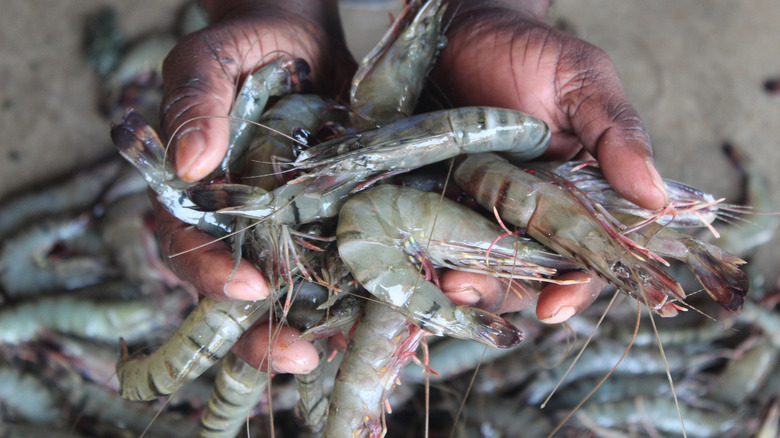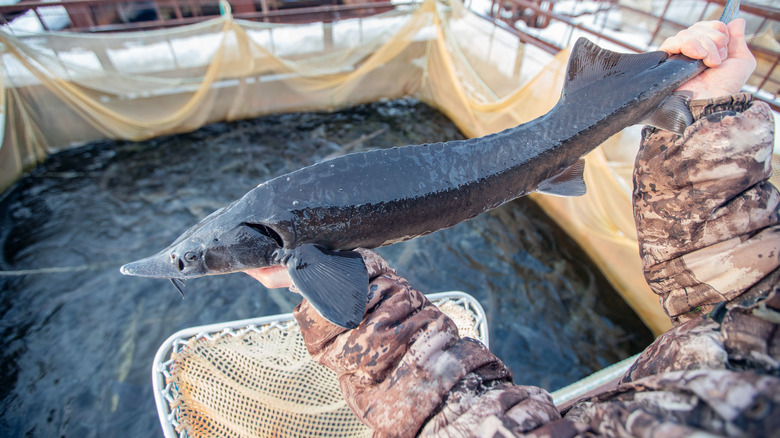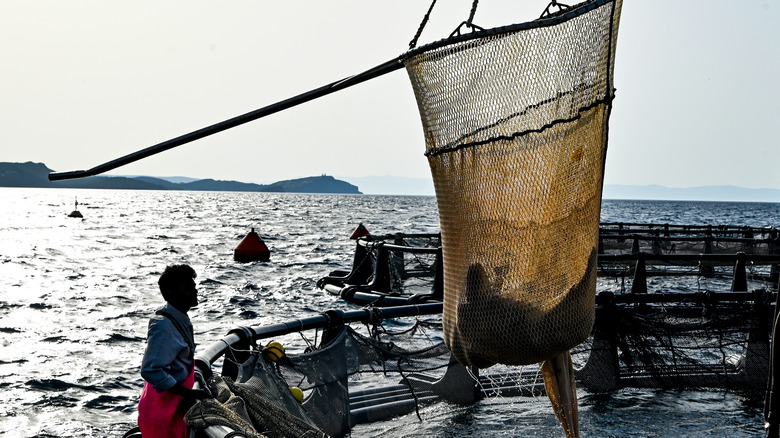The 2 Types Of Aquaculture, Explained
Aquaculture — the practice of growing fish, mollusks, seaweed, and other marine life for human consumption — has been around for 4,000 years, with the first book detailing it, "The Classic of Fish Culture," written by Fan Lai in 475 B.C. (via The Healthy Fish). But over the past 30 years, the practice of aquaculture boomed. The Global Seafood Alliance says about 50% of our seafood comes from aquatic farms today. They project that number will rise to 60% by 2030. Sustainability is the key driver in the push towards farmed seafood, given the global demands for protein, which is expected to double by 2025, according to a brief prepared by the Soneva Dialogue, which claims the key to worldwide protein stability is farm-raised fish.
According to the National Ocean and Atmospheric Administration, aquaculture is more than a food source. It can also contribute to the repopulation of wild species in danger of extinction and help with habitat restoration. As long as its environmental impact is net positive, aquatic farming is considered an integral part of the blue economy, which is the sustainable use of water resources for economic growth (via Forest News). But not all aquaculture is created equal — the two types, marine and freshwater, both have benefits and challenges.
Marine Aquaculture
Marine aquaculture, also called mariculture, farms saltwater finfish, shellfish, seaweeds, and kelps. Finfish like salmon, tuna, and black sea bass are often farm-raised, as are oysters, mussels, shrimp, and clams (via USGS).
Because the wild harvest shellfishing methods often dredge the ocean floor, shellfish farms are given high marks in terms of sustainability (via Sunset Magazine). Since shellfish eat plankton, they aren't feeding on other fish species. Farming methods for shellfish have very little impact on the waterways where the crustaceans are grown.
Saltwater finfish, however, are more difficult to raise sustainably, particularly the larger, more predatory ones (think cod, salmon, halibut, and tuna). These fish are often grown in net pens, which use mesh enclosures to keep the fish from swimming away in the open ocean. Sunset Magazine reports that net pens often do significant damage to the marine environment, contributing to pollution and spreading disease, with the fish often escaping and mixing with the wild stock.
Fresh Water Aquaculture
Freshwater finfish like trout and catfish are produced in freshwater aquaculture systems, which are often grown in manmade ponds or large tanks. The Fish Site claims that freshwater aquaculture is actually feeding more people than marine aquaculture, making it the better choice to fix our global food shortage. Sunset Magazine points out that farmed freshwater fish like tilapia, carp, and catfish grown in tanks or self-contained ponds can't spread disease to wild fish.
A group of researchers writing in The Conversation argue freshwater aquaculture is a better option over mariculture, claiming it's more economical to grow freshwater fish in manmade ponds. Freshwater farmed fish, they argue, eat a vegetable and grain-rich diet, leaving a near-zero impact on wild fisheries to feed the farmed fish. The ocean environment leaves farms vulnerable to storms and can result in the loss of costly equipment. Harvesting saltwater fish is also more expensive than freshwater, which makes freshwater a better choice for budget-conscience consumers.
While much work has been done to make aquaculture a more sustainable practice, it's still rife with controversy, whether farmed in fresh or salt water. From habitat invasion and disease to threats to land and water use, farmed fish may not yet be the panacea to feed the world's growing population.


